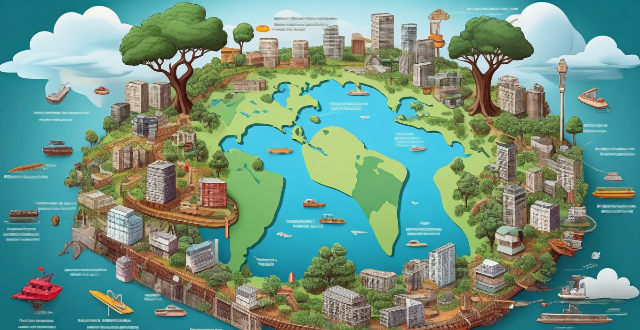The article discusses the main threats to global biodiversity, which include habitat loss and fragmentation due to urbanization, agricultural expansion, and mining and extraction; climate change with rising temperatures, altered precipitation patterns, and extreme weather events; pollution from chemicals, noise, and light; overexploitation through overfishing, hunting and poaching, and harvesting of plants; invasive alien species competing for resources, transmitting diseases, and altering habitats; and human population growth leading to increased consumption, waste production, and conflict with wildlife. These threats are interconnected and require coordinated efforts from various stakeholders to implement sustainable practices and protect our planet's diversity of life.

Main Threats to Global Biodiversity
Biodiversity refers to the variety of life on Earth, including the diversity within species, between species, and across ecosystems. It is essential for maintaining ecological balance and providing various ecosystem services that support human well-being. However, global biodiversity is facing numerous threats, which can be broadly categorized into the following main types:
Habitat Loss and Fragmentation
- Urbanization: The expansion of cities and infrastructure leads to the conversion of natural habitats into built-up areas, reducing the available space for wildlife.
- Agricultural Expansion: The conversion of forests, grasslands, and wetlands into farmland reduces habitat and disrupts ecosystem processes.
- Mining and Extraction: Activities such as logging, mining, and oil drilling destroy habitats and pollute ecosystems.
Climate Change
- Rising Temperatures: As temperatures rise, many species face challenges in adapting to new conditions, leading to range shifts or extinctions.
- Altered Precipitation Patterns: Changes in rainfall patterns affect water availability for plants and animals, impacting their survival and reproduction.
- Extreme Weather Events: Storms, droughts, and heatwaves can cause significant damage to ecosystems and the biodiversity they support.
Pollution
- Chemical Pollution: Pesticides, fertilizers, and industrial chemicals contaminate soil and water, harming organisms at all levels of the food chain.
- Noise Pollution: Anthropogenic noise disrupts animal communication and behavior, affecting mating success and predator avoidance.
- Light Pollution: Artificial light at night alters the behavior of nocturnal species and disrupts ecosystem processes.
Overexploitation
- Overfishing: The removal of fish from oceans and freshwater bodies at rates exceeding their reproductive capacity leads to declines in fish populations.
- Hunting and Poaching: The illegal or unsustainable hunting of wildlife for meat, trophies, or traditional medicine threatens many species with extinction.
- Harvesting of Plants: The overcollection of medicinal plants, timber, and non-timber forest products depletes populations and disrupts ecosystem functions.
Invasive Alien Species
- Competition for Resources: Introduced species often outcompete native ones for food, habitat, or other resources.
- Disease Transmission: Invasive species can carry diseases that native species have not evolved to resist.
- Habitat Alteration: Some invaders change the structure or function of ecosystems in ways that disadvantage native species.
Human Population Growth
- Increased Consumption: A growing human population requires more resources, leading to increased pressure on natural systems.
- Waste Production: More people generate more waste, contributing to pollution and habitat degradation.
- Conflict with Wildlife: As human populations expand into wild areas, conflicts with wildlife increase, often resulting in the loss of animal lives.
In conclusion, these threats are interconnected and exacerbate each other, creating a complex web of challenges for global biodiversity. Addressing these threats requires coordinated efforts from governments, industries, communities, and individuals to implement sustainable practices and protect our planet's rich diversity of life.